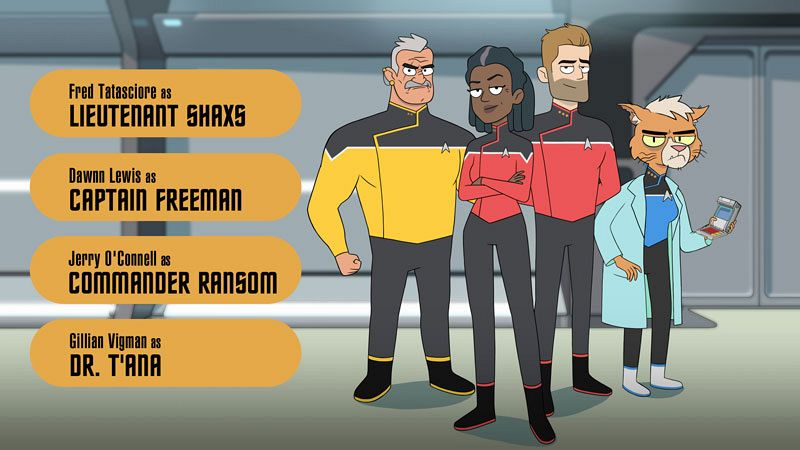THE GIRL WHO MADE THE STARS
EPHRAIM AND DOT
After three live action vignettes, the
second set of Short Treks presents
a double bill of animated shorts, the first animated Star
Trek episodes for forty-five
years. It's surprising that the franchise hasn't explored the
animated medium more often. After all, it's much easier to create
alien life forms, spectacular ships and strange new worlds in cartoon
form than live action. However, while Star Trek: The
Animated Series has experienced
a reassessment in recent years, it's long had a poor reputation, and
this has likely put the blocks on animated Trek for
years.
Now,
however, Alex Kurtzman and his team are pushing the franchise back
into the world of animation, with two new cartoon series planned: the
comedy Star Trek: Lower Decks and
an as-yet untitled Nickelodeon series. To whet our appetites are
these two sweet mini-episodes, which show us how kid-friendly
animated Trek can be
done in the twenty-first century. Both rendered using
computer-generated animation, “The Girl Who Made the Stars” and
“Ephraim and Dot” are cute, straightforward little tales that,
while clearly aimed at children, have something for grown-up fans of
the Star Trek universe. Like
the other Short Treks so
far, they tie into elements of parent series Star Trek:
Discovery.
“The
Girl Who Made the Stars” gives us a glimpse of Michael Burnham's
childhood, before the awful events that would tear apart her family.
We see a very young Michael, here voiced by Kyrie McAlpin, scared of
the dark and unable to sleep. She is consoled by her father Mike,
portrayed by Kenric Green as he was in Discovery's
flashbacks. He tells her the story of a little girl, living in Africa
before even the stars were born, and how her bravery brought the
stars the sky and saved her tribe and all of humanity from darkness.
This is based on a real myth of the /Xam Abathwa, a San people of
southern Africa, and was mentioned by Michael in Discovery's
season two opener, “Brothers.”
It's
good to see Star Trek exploring
what will be lesser known cultures for much of its audience. The
creation myth is embraced and retold in a visually striking and
powerful way. It gives it a Star Trek twist,
with an alien visitor giving the young pioneer the gift of the stars
before returning to space in his ship (although where he's from if
there aren't any stars yet is an intriguing question). The themes of
courage, curiosity and the desire to explore and advance are core
Trek values and it's
good to see them illustrated in another way here. It's also nice to
see some positive backstory for Michael, as well as an exploration of
her ancestry (although the strong African influence on the episode is
somewhat damaged by the visible lightening of the principle
characters' skin compared to the live action actors).
Directed by
Olatunde Osunsanmi, who has worked as exec producer on much of
Discovery and Short Treks so far, and written by
Brandon Schultz, it's a rather beautiful episode, and the animation
is stunning.
“Ephraim and Dot”
is equally family-friendly but takes a very different route. It's a
silly, slapstick sketch starring an alien tardigrade of the species
seen in Discovery's first season, although made significantly
cuter, and a DOT-7 maintenance robot of the type that's been glimpses
affecting repairs on the series. It ties into Discovery by
exploring more of the tardigrade's life cycle and its swimming
through the mycelial network – the fungus-based hyperspace system
that the USS Discovery uses. However, for the most part this
episode riffs on classic Star Trek, to delightful effect.
The tardigrade
doesn't get a name in the episode itself, but she is apparently
called Ephraim. This was, reportedly, the name of the tardigrade
character that at one point was considered for the bridge crew on
Discovery, which would have been bizarre and wonderful. Both
Ephraim and Dot have tons of character in spite of having no dialogue
at all. Ephraim fins her way onto the Enterprise – rather
beautifully rendered in animated style – and lays her eggs in its
workings. Dot kicks Ephraim off the ship, leading her to pursue it,
and her eggs, through years of Star Trek adventures.
We get glimpses of
familiar and memorable Trek episodes and movies, or versions
of them, even using original sound clips to accompany the new
animation. For those following, the adventures we see are “Space
Seed,” “The Naked Time,” “The Trouble With Tribbles,” “Who
Mourns For Adonais?” “The Doomsday
Machine,” “The Tholian Web,” “The Savage Curtain,” The Wrath of Khan
and The Search for Spock. How the eggs manage to stay
undiscovered for twenty years, through a ship-wide refit, is anyone's
guess, but it's a wonderfully nostalgic run through of favourite
moments from the early years of the franchise. There are some
stylistic choices that mean the shots don't quite fit with the
established events, but that's not really here nor there, although
the error of the Enterprise's registration is a glaring one.
Watching Ephraim
and Dot chase each other and scuffle is simple, silly entertainment,
hardly the most taxing thing Trek has presented. Yet there's
still some room for a message, with Dot coming to value the
tardigrade's right to life. It's bookended by an information film
presented in retro style, narrated by Kirk Thatcher, sounding at
times a lot like Leonard Nimoy. Directed by Michael Giacchino,
stepping beyond his role as composer, this is a slight but thoroughly
enjoyable little story. Does this cutesified version of Star Trek
count as canon? I honestly don't care. Sit the kids down and
introduce them to Star Trek.










